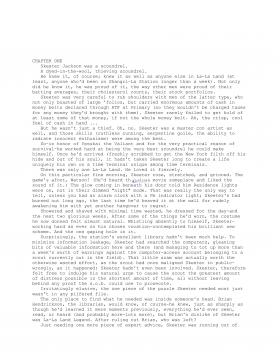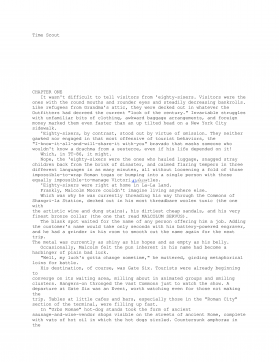having inflicted them on society. Women like Ginny always did a good job, he had found. Long-
legged blondes were all very nice, but when it came to getting things done properly and on time,
he'd settle for the older mommas any day.
"Good morning, Dr. Hunt," she greeted him. One thing he had never been able to persuade
her to accept fully was that Englishmen didn't expect, or really want, to be addressed formally
all the time.
"Hi, Ginny. How are you today?"
"Oh, just fine, I guess."
"Any news about the dog?"
"Good n~ws. The vet called last night and said its pelvis isn't fractured after all. A few
weeks of rest and it should be fine."
"That's good. So what's new this morning? Anything panicky?"
"Not really. Professor Speehan from MIT called a few minutes ago and would like you to
call back before lunch. I'm just finishing going through the mail now. There are a couple of
things I think you'll be interested in. The draft paper from Livermore, I guess you've already
seen."
They spent the next half-hour checking the mail and organizing the day's schedule. By that
time the offices that formed Hunt's see-lion of Navcomms were filling up, and he left to update
himself on a couple of the projects in progress.
Duncan Watt, Hunt's deputy, a theoretical physicist who had transferred from UNSA's
Materials and Structures Division a year and a half earlier, was collecting results on the Pluto
problem from a number of research groups around the country. Compari
Sons of the current solar system with records from the Shapieron of how it had looked
twenty-five million years before established beyond doubt that most of what had been Minerva had
ended up as Pluto. Earth had been formed originally without a sateffite, and Luna had orbited as
the single moon of Minerva. When Minerva broke up, its moon fell inward, toward the Sun, and by a
freak chance was captured by Earth, about which it had orbited stably ever since. The problem was
that so far no mathematical model of the dynamics involved had been able to explain how Pluto
could have acquired enough energy to be lifted against solar gravitation to the position it now
occupied. Astronomers and specialists in celestial mechanics from all over the world had tried all
manner of approaches to the problem but without success, which was not all that surprising since
the Ganymeans themselves had been unable to produce a satisfactory solution.
"The only way you can get it to work is by postulating a threebody reaction," Duncan said,
tossing up his hands in exasperation. "Maybe the war had nothing to do with it. Maybe what broke
Minerva up was something else passing through the solar system."
Thirty minutes later and a few doors farther along the corridor, Hunt found Marie, Jeff,
and two of the students on loan from Princeton, excitedly discussing the set of partial-
differential tensor functions being displayed on a large mural graphics screen.
"It's the latest from Mike Barrow's team at Livermore," Marie told him.
"I've already seen it," Hunt said. "Haven't had a chance to go through it yet, though.
Something about cold fusion, isn't it?"
"What it seems to be saying is that the Ganymeans didn't have to generate high thermal
energies to overcome proton-proton repulsion," Jeff chipped in.
"How'd they do it then?" Hunt asked.
"Sneakily. They started off with the particles being neutrons so there wasn't any
repulsion. Then, when the particles were inside the range of the strong force, they increased the
energy gradient at the particle surfaces sufficiently to initiate pair production. The neutrons
absorbed the positrons to become protons, and the electrons were drawn off. So there you've got it-
two protons strongly coupled. Pow! Fusion."
Hunt was impressed, although he had seen too much of Gany
mean physics by that time to be astounded. "And they could control events like that down
at that level?" he asked.
"That's what Mike's people reckon."
Shortly afterward, an argument developed over one of the details, and Hunt left the group
as they were in the process of placing a call to Livermore for clarification.
It seemed as if the information left by the Ganymeans was all starting to bear fruit at
once, causing something new to break out every day. Caidwell's idea of using Hunt's section as an
international clearinghouse for the research into Ganymean sciences was starting to produce
results. When the first clues concerning Minerva and the Ganymeans were coming to light, Caidwell
had set up Hunt's original pilot group to do exactly this kind of thing. The organization had
proved well suited to the task, and now it formed a ready-made group for tackling the latest
file:///F|/rah/James%20P.%20Hogan/Hogan,%20James%20P%20-%20Giant's%20Star.txt (5 of 137) [2/4/03 10:56:12 PM]

 2024-12-08 12
2024-12-08 12
 2024-12-08 14
2024-12-08 14
 2024-12-08 10
2024-12-08 10
 2024-12-08 10
2024-12-08 10
 2024-12-08 15
2024-12-08 15
 2024-12-08 18
2024-12-08 18
 2024-12-08 27
2024-12-08 27
 2024-12-08 25
2024-12-08 25
 2024-12-08 16
2024-12-08 16
 2024-12-08 30
2024-12-08 30








 渝公网安备50010702506394
渝公网安备50010702506394
